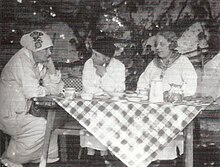Clare Atwood

Clare 'Tony' Atwood (11 May 1866 – 2 August 1962) was a British painter of portraits, still life, landscapes, interiors and decorative flower subjects.[1] Atwood lived in a ménage à trois with the dramatist Christabel Marshall and the actress, theatre director, producer and costume designer Edith Craig from 1916 until Craig's death in 1947.[2][3][4][5]
Early life
Atwood was born in 1866 at Richmond, London, the only daughter of Frederick Atwood, an architect, and his wife, Clara Becker. Named Clara at birth, she later used the form Clare and was also known as Tony. Atwood studied at Westminster School of Art and the Slade School of Fine Art.
She first exhibited at the New English Art Club in 1893, becoming a member in 1912. She held an exhibition of her work at the Carfax Gallery in 1911. In 1917, during World War I, she was commissioned to paint war scenes for the Canadian Government through the Canadian War Memorials Fund. The Fund arranged for Atwood to visit the military camp at Folkestone in Kent to gather ideas for the work. However, instead Atwood decided to paint a YMCA canteen at one of London’s railway stations, where enlisted men were waiting for a train to take them to camps or to the front. In 1920 she was commissioned for four war paintings by the Imperial War Museum.[1][6]
Personal life
A lesbian, in 1916 she joined the writer Christabel Marshall and the actress and stage director Edith Craig in a ménage à trois at Tenterden in Kent until Craig's death in 1947, according to Michael Holroyd in his book A Strange Eventful History.[2] She, Edith Craig and Christabel Marshall were friends with many artists and writers including lesbian novelist Radclyffe Hall.[7] Atwood designed props for several of Edith Craig's productions with the Pioneer Players, including the 16 foot high crucifix for their production of Paul Claudel's The Hostage. Atwood was a member of the Pioneer Players.[8] Atwood occasionally performed at the Barn Theatre at Smallhythe Place in Kent, which was founded by Craig to stage performances in memory of her late mother, the actress Ellen Terry.[9] Atwood acted in the matinée at the Palace Theatre, London on 23 April 1929, held to raise funds for the Ellen Terry Memorial. In July 1932, Atwood decorated the shoe for Craig's production of The Shoe in Tenterden.[6] After Craig's death, Atwood wrote an essay about Craig.[10]
Death
Atwood suffered a fractured femur, senile myocarditis and heart failure, and died at Kench Hill Nursing Home, Tenterden, Kent, on 2 August 1962.
Collections

Atwood's paintings are held in collections Tate Collection, the V&A and Imperial War Museum in London, as well as in the Victoria Art Gallery, Bath, Glasgow, Manchester and Liverpool.[11] She exhibited at the Royal Academy, and in 1940 one of her paintings was purchased by the National Art Gallery of New Zealand.[6]
There is material relating to Clare Atwood held in the Ellen Terry Collection at the V&A Department of Theatre & Performance Archive.[12]
References
- ^ a b [1] Atwood in the Tate Collection
- ^ a b Holroyd, Michael. A Strange Eventful History, Chatto and Windus, 2008
- ^ [2] Los Angeles Times Review A Strange Eventful History: The Dramatic Lives of Ellen Terry, Henry Irving, and Their Remarkable Families by Michael Holroyd, March 23, 2009
- ^ Charlotte Perkins Gilmore: Optimist Reformer, Jill Rudd & Val Gough (editors) University of Iowa Press, p. 90 (1999) Google Books
- ^ Law, Cheryl. Suffrage and Power: the Women's Movement, 1918-1928 . i B Tauris & Co pg 221 (1997) Google Books
- ^ a b c Cockin, Katharine "Atwood, Clare (1866–1962)", Oxford Dictionary of National Biography, Oxford University Press, 2004, accessed 12 March 2010
- ^ Cockin, Katherine. Edith Craig (1869-1947) : dramatic lives. 1998: Cassell.
{{cite book}}: CS1 maint: location (link) - ^ Cockin, Katharine. Women and Theatre in the Age of Suffrage: The Pioneer Players, Palgrave (2001)
- ^ Cockin, Katharine. Edith Craig (1869-1947): Dramatic Lives, Cassell (1998)
- ^ Atwood, Clare. "Edy's Ways", Edy: Recollections of Edith Craig, edited by Eleanor Adlard (1949)
- ^ CMS, Keepthinking - Qi. "Art UK | Home". artuk.org. Retrieved 2016-05-22.
- ^ "Archives Hub". Retrieved 2016-05-22.
